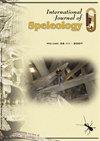捷克共和国易北河峡谷的砂岩裂缝和巨石洞中的洞穴
IF 1.3
4区 地球科学
Q3 GEOSCIENCES, MULTIDISCIPLINARY
引用次数: 0
摘要
捷克共和国北部易北河峡谷白垩纪砂岩中发育的裂隙和巨石洞穴中存在各种洞穴化石。应用一套互补的仪器矿物学方法对洞穴和洞穴滴水进行了表征,包括X射线粉末衍射、扫描电子显微镜和微量分析、拉曼光谱和光学发射光谱。根据其矿物和化学成分,对四种形态类型进行了区分和表征:1,锈褐色泥为主的微刨涂层,由粘土矿物的混合物组成;2、白色“白垩”涂料(月乳),由方解石和少量石膏组成;3、花椰菜状珊瑚由方解石和二氧化硅组成,呈层状结构,顶端有石膏层;4,球状珊瑚状,深灰褐色,表面光滑,层状结构明显,由二氧化硅(石英、蛋白石-A)和硅铝相(高岭石)组成,包括富含磷酸盐的薄层(钠铝石、硅铝石、钽铁矿)。在花椰菜形状的珊瑚中只观察到二氧化硅沉淀的适度微生物介导,而在旋钮珊瑚中没有明显的迹象,尽管最上层的有机物富集。白色“白垩状”涂层和花椰菜状珊瑚状沉积物是从富含钙、镁和硫酸盐的弱酸性深层砂岩渗滤液中沉淀出来的。这些形式可能仍然很活跃,很像微粒粘土沉积产生的微刨。旋钮珊瑚的形成结合了粘土沉积和孔隙水中的主要二氧化硅沉淀,类似于在不断变化的气候条件下(可能在更新世)出现的浅酸性渗滤液。它受到特定岩石岩性(石英砂岩和高岭石混合物)的青睐,这解释了砂岩洞穴中类似形式的稀缺性。突出的垂直边缘上的旋钮珊瑚状物集中,以及风引导形式的存在,表明二氧化硅的沉淀是由恒定气流下的蒸发驱动的。本文章由计算机程序翻译,如有差异,请以英文原文为准。
Speleothems in sandstone crevice and boulder caves of the Elbe River Canyon, Czech Republic
A variety of speleothems are present in crevice and boulder caves developed in Cretaceous sandstones of the Elbe River Canyon in northern Czech Republic. A set of complementary instrumental mineralogical methods was applied to characterize the speleothems and cave dripwaters, including X-ray powder diffraction, scanning electron microscopy and microanalysis, Raman spectroscopy and optical emission spectrometry. Four morphological types were distinguished and characterized in terms of their mineral and chemical composition: 1, rusty brown mud-dominated coatings with micro-gours, composed of a mixture of clay minerals; 2, white “chalky” coatings (moonmilk) composed of calcite with minor gypsum; 3, cauliflower-shaped coralloids composed of calcite and silica in a layered structure, with gypsum layers in apical parts; 4, knob coralloids, dark gray-brown with smooth surfaces and distinctly layered structures, composed of silica (quartz, opal-A) and Si–Al phases (kaolinite) and including phosphate-rich laminae (sasaite, vashegyite, taranakite). Only modest microbial mediation of silica precipitation was observed in cauliflower-shaped coralloids while no clear signs are present in knob coralloids despite organic enrichment in the topmost layer. White “chalky” coatings and cauliflower-shaped coralloids precipitated from weakly acidic Ca-, Mg- and sulphate-rich deeper sandstone percolates. These forms are probably still active, much like the micro-gours, produced by particulate clay deposition. Formation of knob coralloids combined clay deposition and the dominant silica precipitation from pore waters similar to the present shallow acidic percolates under changing climatic conditions, probably in the Pleistocene. It was favored by specific rock lithology (quartzose sandstone with kaolinite admixture), which explains the scarcity of similar forms in sandstone caves. Concentration of knob coralloids along protruding vertical edges and the presence of wind-guided forms suggests that silica precipitation was driven by evaporation under a constant air flow.
求助全文
通过发布文献求助,成功后即可免费获取论文全文。
去求助
来源期刊

International Journal of Speleology
地学-地球科学综合
CiteScore
3.10
自引率
23.10%
发文量
12
审稿时长
>12 weeks
期刊介绍:
The International Journal of Speleology has the aim to get cave and karst science known to an increasing number of scientists and scholars. The journal therefore offers the opportunity to all scientists working in and on karst to publish their original research articles or their review papers in an open access, high quality peer reviewed scientific journal at no cost. The journal offers the authors online first, open access, a free PDF of their article, and a wide range of abstracting and indexing services.
 求助内容:
求助内容: 应助结果提醒方式:
应助结果提醒方式:


